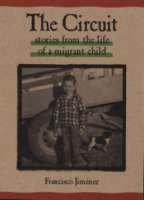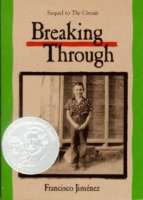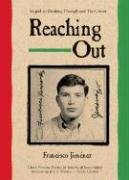Sandy Kaser, University of Arizona, Tucson, Arizona
Many teachers look for ways to make books meaningful to students. Sometimes we go about this in a deliberate way. Perhaps we have a unit of study coming up and so we look for books that offer different perspectives on this particular topic, or we have “umbrella” themes that cover an entire year and find books that support students in making connections and asking questions all year. In pulling books, we are careful to have a range that reflects the identities of the students entrusted to us.
But sometimes, we happen across a book that has an unexpected effect for both our students and ourselves. When that happens, we want to climb up on a roof top somewhere and shout, “This one! Read this one!” But then we discover that other folks have been shouting on that roof top and we just didn’t hear it. And we are all the more amazed. How did we miss it? This is what happened in my classroom with the books of Francisco Jiménez, specifically The Circuit, Breaking Through and Reaching Out.
 There are those who might argue that no “teacher act” lacks deliberation. Teachers make decisions and choices all day long. Perhaps decisions and choices are made quickly but they are based on levels of experience and understandings. I would agree to a certain extent. These decisions are also based in part on what you believe teaching is all about–. your philosophy of teaching–as well as on current curriculum mandates that you may embrace or try to skirt. Your days become this dance of what I want to do, what I must do, what I have time to do, and then comes–What would I like to do differently? What do I need to do differently? Ideas and plans swirl around in your head. Out of this come the deliberate choices. But also out of this come surprises that turn out better than that.
There are those who might argue that no “teacher act” lacks deliberation. Teachers make decisions and choices all day long. Perhaps decisions and choices are made quickly but they are based on levels of experience and understandings. I would agree to a certain extent. These decisions are also based in part on what you believe teaching is all about–. your philosophy of teaching–as well as on current curriculum mandates that you may embrace or try to skirt. Your days become this dance of what I want to do, what I must do, what I have time to do, and then comes–What would I like to do differently? What do I need to do differently? Ideas and plans swirl around in your head. Out of this come the deliberate choices. But also out of this come surprises that turn out better than that.
A few years back, I was asked to be the SEI (Structured English Immersion) instructor for my grade level. This means my class receives all of the fifth grade students who have a primary language other than English. I also get the students who have recently tested out of the program and are referred to with the endearing term “reclassifieds.” And so, each year, my class is made up of a high percentage of students who have a first language other than English. Most of my students last year were Spanish speakers with direct ties to Mexico. They may have been born in Mexico, or have relatives in Mexico, or have a family in which a parent still lives and works in Mexico. Almost all took trips to Mexico for once reason or another.
I do not speak Spanish and I have no connections to Mexico other than my students and their families, and so I was concerned about how to support their identities with literature in ways that were reasonably authentic. I started the year with Esperanza Rising by Pam Muñoz Ryan, a great book about a wealthy girl from Mexico who is forced to escape to the United States where she became part of a group of migrant farm workers. The book was an enormous success with my students. Not all children’s books on tape are good, but Esperanza is excellent on tape. I used it as my “read aloud” traditionally done after lunch. Each student had a copy of the book to follow along with “eyes across text,” but they could hear the story as well. The students loved the words in the book written in Spanish and were quick to explain what the words meant and pronounce them for me. This book was not a formal “study” but rather a jazzed up read aloud. This book opened up an interesting dialogue following the read aloud related to migrant farm workers. But mostly we just enjoyed the book and focused on the changes in the character and personality of Esperanza.
A few years earlier, I attended the NCTE (National Council of Teachers of English) conference and heard professional conversations around the use of non-fiction literature in the classroom. Teachers were urged to include more non-fiction in the classroom, and to try reading non-fiction aloud. I attended sessions on the importance of including biography in units of study. It was all very intriguing. And of course I ventured into the book display area and looked a little harder at the non-fiction books.
There it was. The Circuit by Francisco Jiménez. Right on the front cover were the words, “stories from the life of a migrant child.” My first thought was how this could be a non-fiction piece that would go along with Esperanza. Although Esperanza was based on Pam Muñoz Ryan’s grandmother, The Circuit sounded like more of a biography/memoir. So, basking in the glow of my recent non-fiction sessions at the conference, I bought it. I took it home and put it on the stack of “Books I haven’t read yet.” I didn’t think of it again until my class listened to Esperanza Rising. Then I went hunting for that little book I bought at NCTE a couple of years ago.
I began to read the short stories aloud to the class before I had read the book myself. After all, it had been sitting on the pile for two years so the chances of my reading it to myself did not seem to be very good. I don’t think you are really supposed to read a book to your students that you have not yet read yourself – that is probably in the “things not to do” guide for teachers, but as I said, this was not all that well planned out. I found the book and took it to school. I reasoned that it was a book of short stories–personal narratives. I would read one or two to my class and if they were not of interest, I would simply quit. So, reading this book to my class really fell into the serendipitous side of the ledger.
 When I lit my story candle, after lunch and told my students I was going to begin reading a biography of a child who was part of a real migrant farm worker family, a student looked up and said, “How long is it?” Ahhhhh, the love of Esperanza was not enough to keep up an interest in the life of migrant farm workers. Or maybe a non-fiction biography read aloud did not sound all that inviting. Or maybe they thought César Chávez had fixed everything. Yet I knew, based on their responses to Esperanza and Chávez that they were interested. So I forged ahead.
When I lit my story candle, after lunch and told my students I was going to begin reading a biography of a child who was part of a real migrant farm worker family, a student looked up and said, “How long is it?” Ahhhhh, the love of Esperanza was not enough to keep up an interest in the life of migrant farm workers. Or maybe a non-fiction biography read aloud did not sound all that inviting. Or maybe they thought César Chávez had fixed everything. Yet I knew, based on their responses to Esperanza and Chávez that they were interested. So I forged ahead.
 Little did I know as I lit that story candle, climbed on my teacher stool, and opened The Circuit, that I was about to embark on an exceptionally meaningful literature engagement with my fifth grade students that not only took us all the way though The Circuit, also to Breaking Through and Reaching Out and a wish for more. I am not a teacher who insists my students write to authors, but by the time we finished, my class felt like Francisco Jiménez was a member of their families, and they wanted to CALL him. We wrote letters instead. And you could have heard a pin drop when I told them he had replied in an email.
Little did I know as I lit that story candle, climbed on my teacher stool, and opened The Circuit, that I was about to embark on an exceptionally meaningful literature engagement with my fifth grade students that not only took us all the way though The Circuit, also to Breaking Through and Reaching Out and a wish for more. I am not a teacher who insists my students write to authors, but by the time we finished, my class felt like Francisco Jiménez was a member of their families, and they wanted to CALL him. We wrote letters instead. And you could have heard a pin drop when I told them he had replied in an email.
I read them the email and then a student’s voice broke the silence saying, “Mrs. Kaser, we read his books and those were his words in his books, but the words in his letter are his words to US.”
Francisco Jiménez started life as a child in a family who were migrant farm workers and that was my beginning connection and reason for bringing the book into the classroom. But the truth is that it was the person of Francisco Jimenez that my students connected with, and therein lies the surprise. Yes, we all learned more about the challenges of the migrant worker’s way of life, but mostly we learned about how to live a life of purpose, a strong life, a life of integrity in whatever circumstances we find ourselves.
Next Monday, I will write about the class dialogue and student connections that resulted from the reading the work of Franciso Jiménez.
Journey through Worlds of Words during our open reading hours: Monday-Friday, 9 a.m. to 5 p.m. and Saturday, 9 a.m. to 1 p.m. To view our complete offerings of WOW Currents, please visit archival stream.
- Themes: Francisco Jiménez, Sandy Kaser
- Descriptors: Books & Resources, Student Connections, WOW Currents

Mrs Kaser’s comments are enlightening and educational. She speaks on a level that even the less educated, such as I, can understand. Having just discovered the WOW site, I am Wowed by it.
Many times I find words totally lack the needed elements to accurately describe the feelings I have. When this happens; blundering, confusing, ideas and thoughts escape from my mind, into the minds of others, causing a conflict in their thoughts and feelings toward me. This defeats my primary purpose in communicating.
Mrs Kaser does not have this problem. Now I have three books to find and read. Thanks for WOWing me. Dale
“But sometimes, we happen across a book that has an unexpected effect for both our students and ourselves” Sandy makes such a critical point for today’s classrooms. With the current trend toward adequate progress meeting standards through a national curriculum are we not so focused on “adequate” learning that squeezes out the space for “profound” learning that may occur in a serendipitous turn in curricular choice.